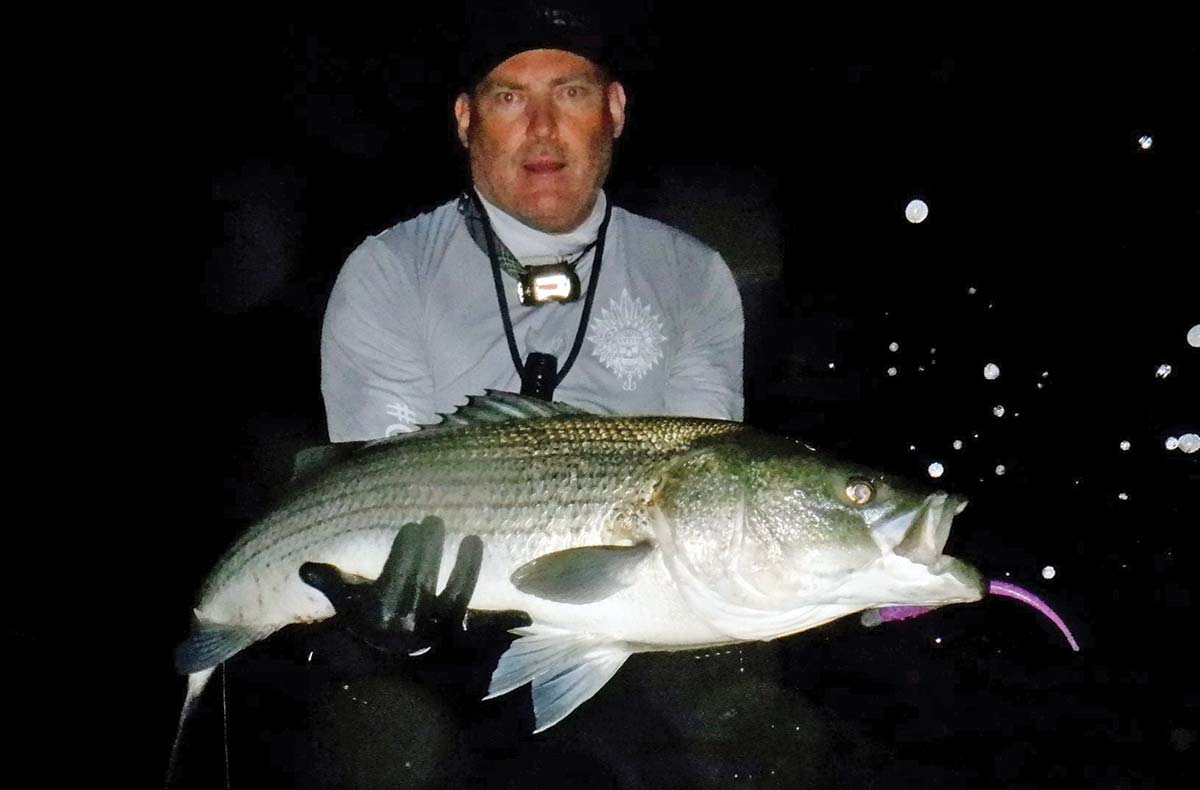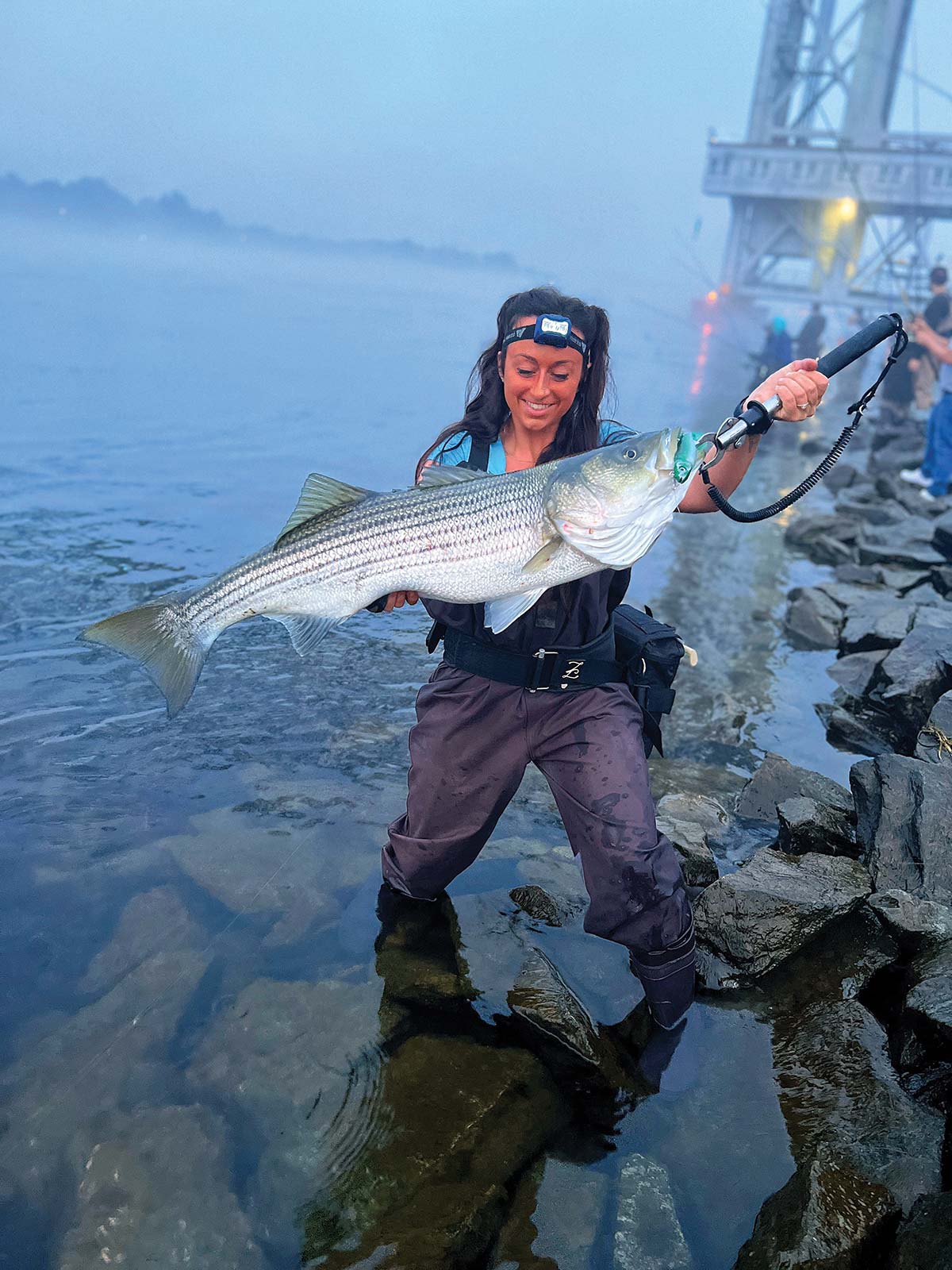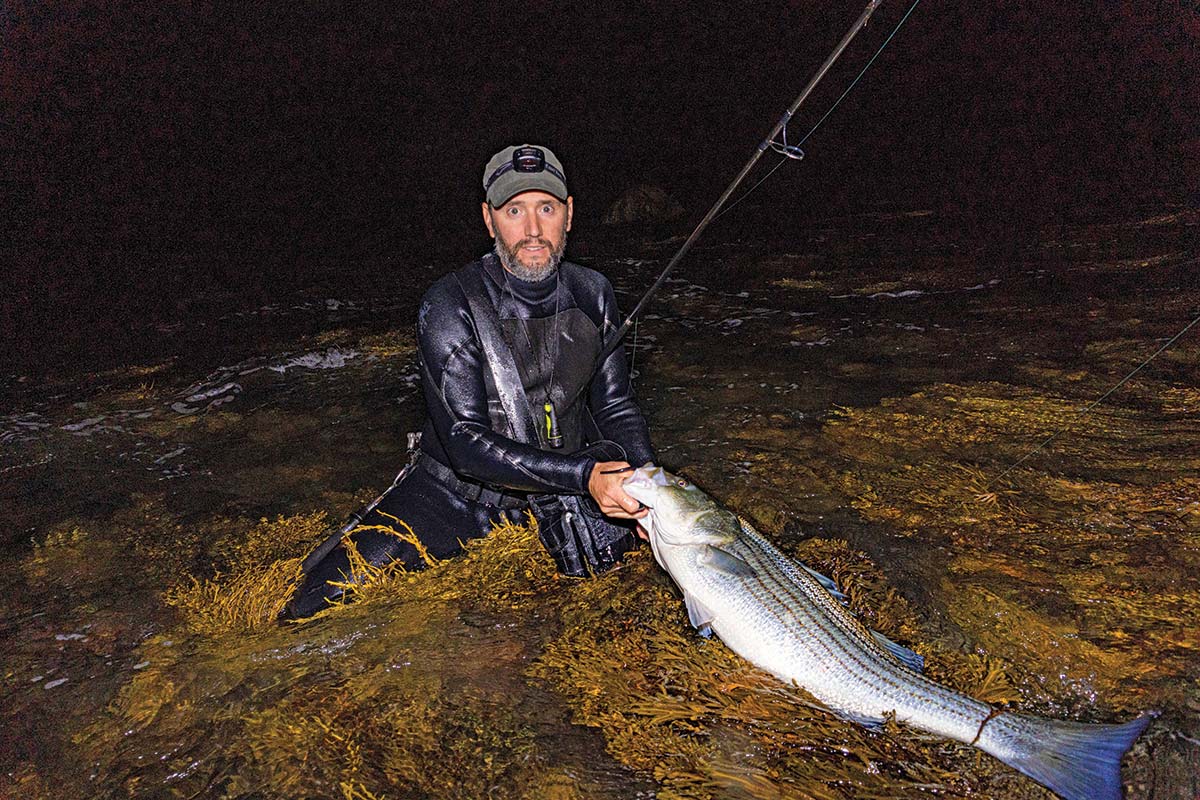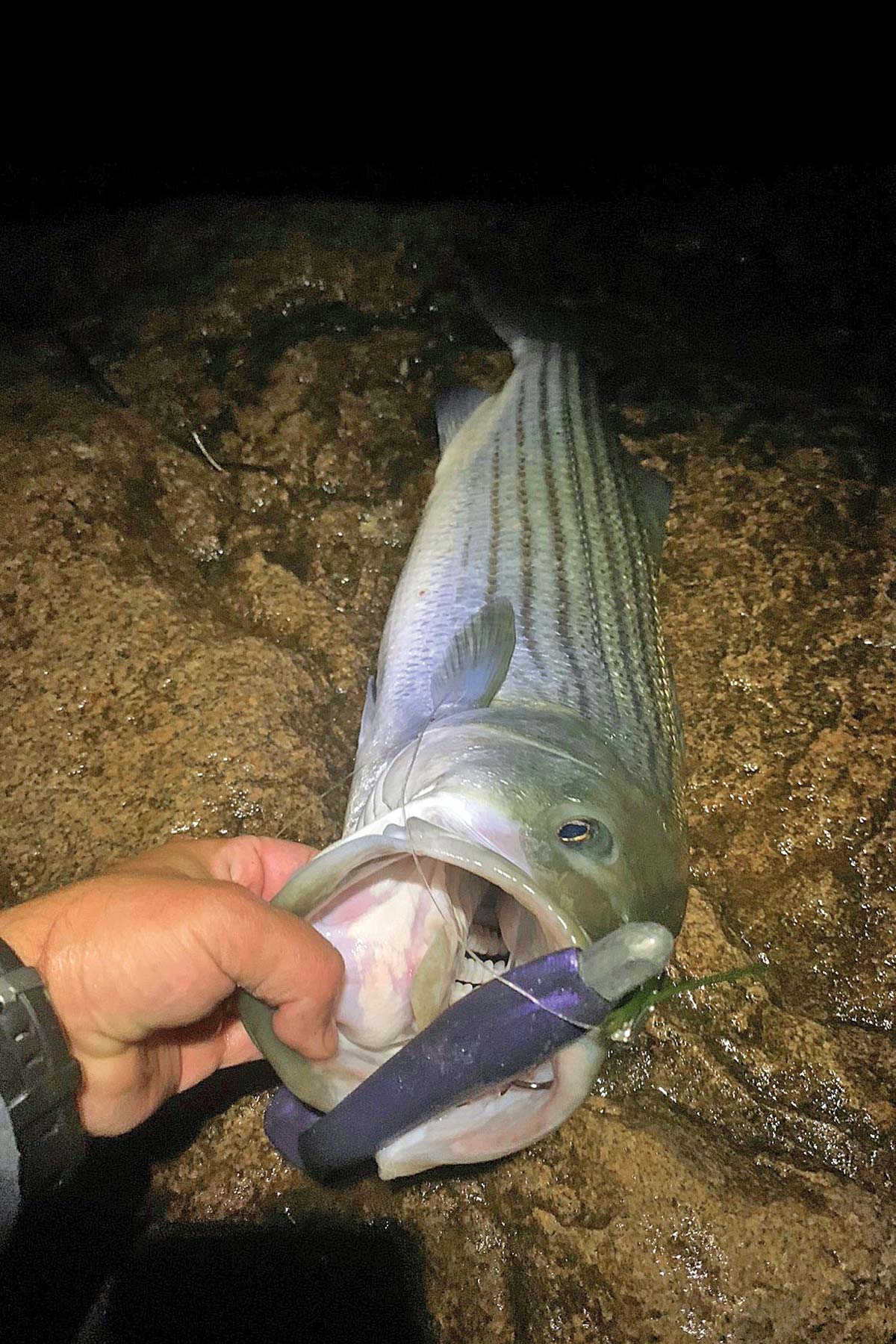
I remember the first time I heard about a surfcaster using soft plastics. This was back in the early-1990s when I was a kid. A new tackle shop opened up in the center of my town and they had hundreds of soft plastic styles in dozens upon dozens of colors. At the time, I was obsessed with Slug-Go’s and they had a knock-off version in about 9 million colors, so I was constantly riding my bike there to spend my allowance on baits.
Earl was one of the owners and I overheard him talking about catching a 60-pound striper on their 7-inch knock-off Slug-Go in ‘root beer’ color; he said he caught it from Race Point on Cape Cod. At the time, I actually didn’t believe him because I assumed that a long cast was required to hook a large fish from the surf and I thought stripers would only eat plugs or bait. I’ve come around in the 30 years since.
My initiation to soft plastics in the surf could have started a lot sooner than it did. When I was 16 I caught my first ‘decent’ striper from the surf and that fish gave way to a full-on obsession. At the time, I didn’t have my driver’s license so I begged my parents to plan a family day at the beach, which was 2 hours away! I got them to do it twice and, needless to say, upon arriving, I abandoned my family to walk out to Nauset Inlet to fish for stripers. On one of those trips I tried a Slug-Go that I had brought from my freshwater box and hooked a 25-inch striper within a few casts. But that would be the only striper I landed on soft plastics for about six years when I was introduced to the Swim Shad.
Make Good Choices
These days, I never leave to fish the surf without soft plastics; whether it’s Zoom Flukes and Albie Snax in the spring or late-fall or larger baits like Super Snax, NLBN, Ron-Z, Slug-Go’s or Mega Shads during the meat of the season. Some hardcore plug purists might ask “why” and I don’t think I could say it better than my friend and Surfcaster’s Journal columnist Al Albano; I’m paraphrasing but he said something like, “You really don’t know if there are fish around until you’ve thrown a Slug-Go on a jighead, I can’t tell you how many times I’ve struck out on all my favorite plugs only to hook up on the soft plastic!”
There are several factors that you can use to steer yourself in the direction of choosing the right soft plastic. There are three main styles that surfcasters typically use; you have stickbaits, straight-tail baits and paddletail baits. These baits all have their place and, while they can be used interchangeably in some situations, there are scenarios where one style seems to clearly out-fish the others.

Paddletails
I don’t think I need to describe a paddletail bait at this point, nearly every fisherman has used them and we all know that the little foot-shaped tab or ‘paddle’ on the tail catches water which causes the rear third of the bait to wobble back and forth, making it appear as though it were swimming. Luckily the fish like them just about as much as we all liked the way they looked in the water the first time we saw one.
Not all paddletails are created equal, I’ve used some that barely wiggled at all – I won’t mention any names – but I’ve since learned to look at the angle of the ‘foot’ and also how sturdy the tapered portion that attaches the tail to the body is. Basically, it needs to be sturdy enough to stand up to the force of the water flowing over it, but not so sturdy that it can’t wobble. For instance there are these two baits made by MegaBass the MagDraft and the MagSlowl. The MagDraft is a killer swimbait, the MagSlowl is identical except the piece that connects to the paddletail is about as thin as linguine, it’s so flimsy that the tail just bends upwards and doesn’t wiggle. A good way to test a new paddletail is to hold it vertical with the tail facing up, if it just flops over to one side, I’d skip it, but if, with just a little encouragement, it will wag to and fro, it’s probably a winner. The last thing to look at is the angle of the foot, you really want it to be steeper than 45 degrees, with 30 being roughly the sweet spot – anything 45 degrees or more and the action will either be diminished or nonexistent.
In my experience, a paddletail bait really excels in daylight. This is a general observation and not meant to be a rule. I love to throw this style lure when the fish are pushing bait and the baitfish are running for their lives. There’s something about that tail that just draws predator fish to the bait and I think it’s the frantic pulsing of the tail, they just home in on it. And don’t be afraid to stomp on the gas pedal, faster is often better in these situations.
The next scenario that tells me I need to snap on a paddletail is fishing slow, deep water, especially in the dark. In this scenario, I want to match the bait with a jighead that will get it down close to the bottom, but also allow me to swim it slowly along without dragging. The paddletail helps ‘hang’ the bait on a tight line, almost like a drift sock, keeping the bait swimming along without clunking down on the bottom. The last scenario that makes me dig out a paddletail is when I see lots of baitfish waking on the surface, it could be mackerel, bunker or especially mullet. You can pull it off with a jighead, but I really like to use a weighted swimbait hook for this.
Experiment with your favorite paddletails to dial in the correct weight; you want it to be easy to swim on or near the surface but also heavy enough that it won’t roll out. This method is a ton of fun because the hits are highly visual and often charged with competition. Are there other scenarios? Absolutely, but for me, these are the three main scenarios when a paddletail bait is the right choice. Some of my favorites are Zman SwimmerZ, Al Gag’s Whip-It Fish, Housatonic Lures Paddletails and both the 5- and 8-inch NLBN.

Straight-Tails
Some call them rat-tail baits, I often find myself describing them as having a ‘puppy-dog tail’, but these baits usually feature a wider, streamlined body with an elongated and narrow, snakelike, tail. Popular styles you might be familiar with include Super Snax, Bomba Shads and, the bait that sort of started it all for surfcasters, the MegaShad. These baits probably originated from freshwater soft plastics like the BassAssasin or Fluke style baits, but were increased in size to meet the needs of the surfcaster. The cool thing is that the extra length translates to a ton of extra movement in the water. Where Flukes and Assassins are considered jerkbaits in their smaller sizes, their longer siblings undulate like an eel, even with no tip action from the angler.
In my opinion, this style of bait is the best one for ‘conventional’ surf situations; casting from an open beach or fishing in a boulder field. In fact, a blurple Super Snax on a half- to 1-1/2-ounce leadhead is often the first thing out of my bag, especially during the fall run. The reason I throw them so often is their versatility; they are effective at a crawl, a frenetic crank, and all speeds in between. They are also easy to fish at all levels of the inshore water column. In my opinion, straight-tail soft plastics are the ultimate search-bait.
And a word to the wise, don’t forget to try casting into fishy water and just letting the bait descend through the water column on a tight line – I’ve had many nights when this simple method accounted for some really nice fish when other modes were being mostly ignored.
A situation that always leaves me digging in my bag for a straight-tail bait is when I find mid-sized bait being pushed into the shallows at night, like mullet, large peanuts or mackerel. When I encounter this situation, I throw my lure out past the action and – quite literally – reel as fast as I can! I believe this presents as a panicked baitfish making a suicide run for the shallows. The hits… oh my-my, they will leave you weak in the knees and begging for more! The only key to this situation is using a heavy enough jighead, too light and they’ll mostly just skitter along the surface. Start with at least an ounce and increase as you see fit – I’ve never felt I needed more than 2.
Stickbaits
Stickbaits are largely derivatives of the ubiquitous Slug-Go. They feature a stiffer and beefier body than a straight-tail bait. When rigged on an unweighted swimbait hook, a twitchy retrieve will bring the bait to life in a wonderful dance of random darting. This retrieve will get the bait veering left, right, up and down in a way that striped bass definitely read as an easy takedown. Rigged on a lightly-weighted swimbait hook, a stickbait will come through the water like a soft needlefish on a straight retrieve and you can still get some of that side-to-side darting action when twitched.
When fishing them on a jighead, I typically don’t use anything larger than 9 inches (one exception being the HeroZ from Zman). I find the larger baits to be too bulky and buoyant for most of my fishing. If I do fish something like a 12-inch Slug-Go, I will typically tandem rig it, like a rigged eel. A few stickbaits that you might be familiar with include, the Slug-Go, Zman HeroZ, Albie Snax, GT Eels, Game On Big Ochi and NLBN Straight Tails.
I must admit that this style is the one I use the least, which probably has more to do with how much I like the other two styles than anything else. I find that the stickbait shines brightest when I can take advantage of its buoyancy; fishing it unweighted. One of the most natural presentations involves dead-sticking a soft bait and allowing the current to introduce it to the situation and swing it through the strike zone. Baitfish instinctually know that they are vulnerable to attack and they also seem to know that one of the ways predator fish can find them is through the vibrations they give off when swimming. It’s not uncommon to see baitfish like silversides or squid just riding the tide – this is a form of ‘vibrational camouflage’ through which they can survive a gauntlet of stripers simply by not moving. Striped bass though don’t need vibration to detect prey in the dark, they can sense their presence through water displacement and the buoyancy of a soft stickbait coupled with the natural feel of the supple plastic is often a winning combination. I especially like this method in tidal rivers or back bay situations and I feel like it’s a play that very few anglers have the patience to run.
And of course the 7-inch Slug-Go or a 6-inch Ron-Z paired with a light head is not only one of the best baits for getting bit when nothing else is working, but it’s also deadly when the bass are rooting sand eels out of the sand.

Jigging & Rigging
Now we come to the business end of the equation, the hook. Surfcasters lean heavily on jigheads when using soft plastics and there’s more to them than meets the eye. The most debated component of a jighead is of course the hook. On one hand you have the anglers that put a stout hook ahead of everything else and then you have those that prefer a thinner and sharper hook. A thinner hook will penetrate more easily, but a thicker hook will withstand more punishment, I use both. My favorite jigheads are Zman HeadlockZ and Jeck’s, I’ve recently found that I also love the NLBN jigheads, and I’ll pair them with any soft plastic bait that will fit on them.
I’m not super picky about head style, I feel like they all do the same job, but I definitely use the ‘gumdrop’ heads more than any other. The location of the line tie actually makes a big difference. Most jigheads have a line tie that protrudes from top of the head, but some of the newer styles feature an upturned line tie that’s situated right behind the nose. Those with the nose-positioned line tie actually can impart some rolling or darting action to the bait, especially if the heads are on the lighter side – this can be good and sometimes detrimental. Generally speaking the benefits come at slower retrieves and the detriments come with high-speed fishing, because they may roll out to one side and lose their action completely. The top-positioned line tie is reliable for all applications but really excels when deep jigging or when cranking at a high rate of speed.
| THE NLBN MULLET |
| If you want to try something new and different, let me be the first to enlighten you about a very cool new bait. No Live Bait Needed (NLBN) released a new stickbait last year that integrates some cool features. First of all, they look like the real thing, complete with those big, beady mullet eyes. But the coolest design aspect is the angled pectoral fins. As a lure builder I saw those and knew immediately what they were for; the fins create lift, keeping the bait up near the surface when rigged on an unweighted swimbait hook. This soft plastic works like a slow-sink spook and might be the best walk-the-dog soft bait I’ve ever used. But if you push it a little harder, those fins will also force the NLBN Mullet to take to the air in a realistic leap that sells a final attempt to escape the jaws of certain death. And in my experience, this leap usually seals the deal. |
For rigging with a swimbait hook, I have found that there is a huge benefit to using high-quality and deathly sharp hooks. I pretty much only use Owner Beasts and BKK ____. You really need to have that sticky-sharp point when fishing baits rigged in this manner, especially when using thicker plastics – if you don’t get a perfect hookset, the super sharp hook will be your best friend forever.
Soft plastics are a valuable tool for surfcasters all over the East Coast and beyond. Taking some time to understand the styles, their strengths and shortcomings and the nuances that come with different rigs will help you make the right choices in the field. If you have resisted adding soft plastics to your plug bag, you’re falling short on your potential as a striper fisherman, it’s that simple.


